change wheel CITROEN C4 2019 Owners Manual
[x] Cancel search | Manufacturer: CITROEN, Model Year: 2019, Model line: C4, Model: CITROEN C4 2019Pages: 317, PDF Size: 9.31 MB
Page 12 of 317

10
C4-cactus_en_Chap00c_eco-conduite_ed01-2016
Limit the causes of excess consumption
Spreadô loadsô throughoutô theô vehicle;ô placeô theô heaviestô itemsô inô theô bottom ô of ô the ô boot, ô as ô close ô as ô possible ô to ô the ô rear ô seats.
Limit
ô the ô loads ô carried ô in ô the ô vehicle ô and ô reduce ô wind ô resistance ô (roof ô
b
ars, ô roof ô rack, ô bicycle ô carrier, ô trailer...). ô Use ô a ô roof ô box ô in ô preference.
Remove
ô roof ô bars ô and ô roof ô racks ô after ô use.
At
ô the ô end ô of ô winter, ô remove ô snow ô tyres ô and ô refit ô your ô summer ô tyres.
Observe the recommendations on
maintenance
Checkô theô tyreô pressuresô regularly,ô whenô cold,ô referringô toô theô labelô inô the ô door ô aperture, ô driver's ô side.
Carry
ô out ô this ô check ô in ô particular:
-
ô
b
efore ô a ô long ô journey,
-
ô
a
t ô each ô change ô of ô season,
-
ô
a
fter ô a ô long ô period ô out ô of ô use.
Don't
ô forget ô the ô spare ô wheel ô and ô the ô tyres ô on ô any ô trailer ô or ô caravan.
Have
ô your ô vehicle ô serviced ô regularly ô (engine ô oil, ô oil ô filter, ô air ô filter, ô
p
assenger ô compartment ô filter...) ô and ô observe ô the ô schedule ô of ô
o
perations ô in ô the ô personalised ô servicing ô schedule ô for ô your ô vehicle.
With
ô a ô BlueHDi ô Diesel ô engine, ô if ô the ô SCR ô system ô develops ô a ô fault, ô
y
our ô vehicle ô becomes ô polluting; ô go ô to ô a ô CITROûN ô dealer ô or ô a ô qualified ô
w
orkshop ô without ô delay ô to ô have ô the ô emissions ô of ô nitrous ô oxides ô brought ô
w
ithin ô the ô limits ô set ô by ô the ô directive.
When
ô refuelling, ô do ô not ô continue ô after ô the ô third ô cut-off ô of ô the ô nozzle ô to ô
a
void ô any ô over flow.
At
ô the ô wheel ô of ô your ô new ô vehicle, ô it ô is ô only ô after ô the ô first ô 1 ô 800 ô miles ô
(3
ô 000 ô kilometres) ô that ô you ô will ô see ô the ô fuel ô consumption ô settle ô down ô to ô
a
ô consistent ô average.
Eco-driving
Page 56 of 317

54
C4-cactus_en_Chap03_Ergonomie-et-confort_ed01-2016
Rear view mirror
Equippedô withô anô anti-dazzleô system,ô whichô darkens ô the ô mirror ô glass ô and ô reduces ô the ô
n
uisance to the driver caused by the sun,
headlamps
ô from ô other ô vehicles...
Adjustment
Fô Adjustô the ô mirror ô so ô that ô the ô glass ô is ô d
irected ô correctly ô in ô the ô "day" ô position.
Day / night position
Fô Pullô the ô lever ô to ô change ô to ô the ô "night" ô anti-
dazzle ô position.
F
ô
P
ush ô the ô lever ô to ô change ô to ô the ô normal ô
"
day" ô position.
Steeringô wheelô ad justment
F When stationary , lower the control lever A
to ô release ô the ô steering ô wheel ô adjustment ô
m
echanism.
F
ô
A
djust ô the ô height ô of ô the ô steering ô wheel ô to ô
s
uit ô your ô driving ô position.
F
Ra
ise the control lever A ô to ô lock ô the ô
s
teering ô wheel ô adjustment ô mechanism.
As a safety precaution, these
operations should only be carried out
while
ô the ô vehicle ô is ô stationary.
Correct driving position
Beforeô takingô toô theô roadô andô toô makeô theô mostô of ô t he ô e rgonomics ô o f ô y our ô d riving ô p osition, ô c arry ô
o
ut ô these ô adjustments ô in ô the ô following ô order:
-
ô
h
eight ô of ô the ô head ô restraint,
-
ô
b
ackrest ô angle,
-
ô
c
ushion ô height,
-
ô
l
ongitudinal ô position ô of ô the ô seat,
-
ô
h
eight ô of ô the ô steering ô wheel,
-
ô
t
he ô interior ô and ô door ô mirrors.
Once
ô these ô adjustments ô have ô been ô made,
ô e
nsure ô that ô from ô your ô driving ô position ô you
ô c
an ô see ô the ô instrument ô panel ô clearly.
Ease of use and comfort
Page 129 of 317
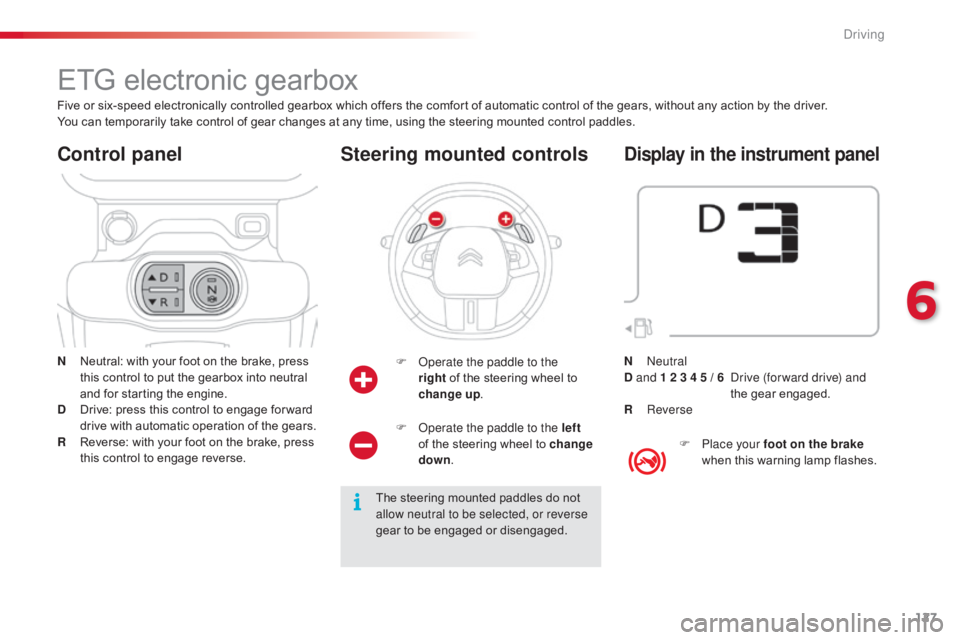
127
C4-cactus_en_Chap06_conduite_ed01-2016
ETGô electronicô gearbox
Nô Neutral:ô with ô your ô foot ô on ô the ô brake, ô press ô t
his ô control ô to ô put ô the ô gearbox ô into ô neutral ô
a
nd ô for ô starting ô the ô engine.
D
ô
D
rive: ô press ô this ô control ô to ô engage ô for ward ô
d
rive ô with ô automatic ô operation ô of ô the ô gears.
R
ô
R
everse: ô with ô your ô foot ô on ô the ô brake, ô press ô
t
his ô control ô to ô engage ô reverse.
Control panel
F Operate the paddle to the rightô of ô the ô steering ô wheel ô to ô
ch
ange
up.
Steering mounted controls
Theô steeringô mountedô paddlesô doô notô a
llow neutral to be selected, or reverse
gear
ô to ô be ô engaged ô or ô disengaged.
Five
ô
or
ô
six-speed
ô
electronically
ô
controlled
ô
gearbox
ô
which
ô
offers ô the ô comfort ô of ô automatic ô control ô of ô the ô gears, ô without ô any ô action ô by ô the ô driver.
You
ô
can
ô
temporarily
ô
take
ô
control
ô
of
ô
gear
ô
changes
ô
at
ô
any
ô
time, ô using ô the ô steering ô mounted ô control ô paddles.
F
O
perate the paddle to the left
of ô the ô steering ô wheel ô to ô change
down .
Display in the instrument panel
F Place your foot on the brake
when ô this ô warning ô lamp ô flashes.
N
Neutral
D and 1 2 3 4 5 / 6
D
rive (for ward drive) and
the
ô g
ear
ô enga
ged.
R
Reverse
6
Driving
Page 142 of 317

140
C4-cactus_en_Chap06_conduite_ed01-2016
Flashingô ofô theô dashesô indicatesô aô faultô withô theô cruise ô control.
Have
ô it ô checked ô by ô a ô CITROûN ô dealer ô or ô a ô
q
ualified
ô w
orkshop.
Operating fault Switching off
F Turn wheel 1 to the "0"ô p osition.ô T
he ô display ô of ô information ô related ô to ô the ô
c
ruise ô control ô disappears. When the cruise control is switched on,
be
ô careful ô if ô you ô maintain ô the ô pressure ô o
n ô one ô of ô the ô programmed ô speed ô
c
hanging ô buttons: ô this ô may ô result ô in ô a ô
v
ery ô rapid ô change ô in ô the ô speed ô of ô your ô
v
ehicle.
Do not use the cruise control on
slippery
ô roads ô or ô in ô heavy ô traffic.
On a steep descent, the cruise control
will not be able to prevent the vehicle
from
ô exceeding ô the ô programmed ô speed.
On
ô steep ô climbs ô or ô when ô towing, ô the ô
p
rogrammed ô speed ô may ô not ô be ô reached ô
o
r ô maintained.
The
ô use ô of ô mats ô not ô approved ô by ô
C
ITROûN ô may ô inter fere ô with ô the ô
o
peration ô of ô the ô cruise ô control.
To
ô avoid ô any ô risk ô of ô jamming ô of ô the ô
ped
als:
-
ô
e
nsure ô that ô the ô mat ô is ô secured ô
c
o r r e c t l y,
-
ô
n
ever ô fit ô one ô mat ô on ô top ô of ô another.
It
ô
is
ô
possible
ô
to
ô
exceed
ô
the
ô
programmed
ô
speed
ô
t
emporarily
ô
by
ô
pressing
ô
the
ô
accelerator
ô
pedal.
To
ô
return
ô
to
ô
the
ô
programmed
ô
speed,
ô
simply
ô
r
elease the accelerator pedal until the
programmed
ô
cruise
ô
speed
ô
is
ô
reached
ô
again.
Exceeding the programmed
speed
Once switched on, you can pause the cruise
control ô at ô any ô time ô by ô pressing ô button ô 4: ô the ô
s
creen ô confirms ô the ô pause.
Pause
Ifô theô programmedô speedô isô exceeded,ô the ô displayed ô speed ô flashes.
Once the speed of the vehicle returns
to
ô the ô programmed ô speed ô setting, ô the ô
d
isplay ô becomes ô steady ô again.
The cruise control is paused
ô m
anually
ô o
r ô by ô pressing ô the ô brake ô or ô clutch ô pedal ô
o
r ô if ô the ô ESC ô system ô is ô invoked ô for ô
s
afety ô reasons.
Driving
Page 147 of 317
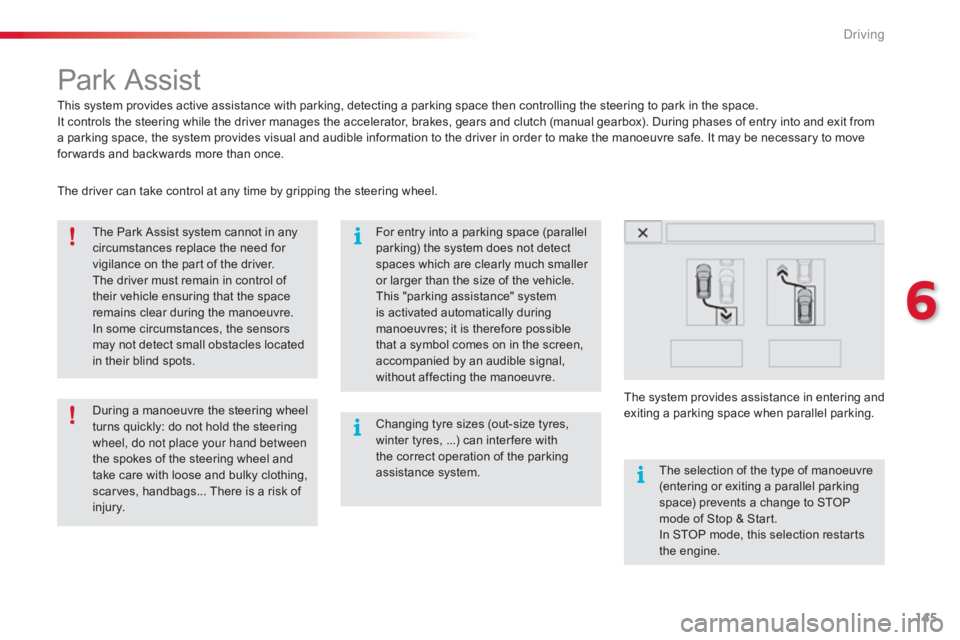
145
C4-cactus_en_Chap06_conduite_ed01-2016
Parkô Assist
Thisô systemô providesô activeô assistanceô withô parking,ô detectingô aô parkingô spaceô thenô controllingô theô steeringô toô parkô inô theô space.
I t ô controls ô the ô steering ô while ô the ô driver ô manages ô the ô accelerator, ô brakes, ô gears ô and ô clutch ô (manual ô gearbox). ô During ô phases ô of ô entry ô into ô and ô exit ô from ô
a
ô parking ô space, ô the ô system ô provides ô visual ô and ô audible ô information ô to ô the ô driver ô in ô order ô to ô make ô the ô manoeuvre ô safe. ô It ô may ô be ô necessary ô to ô move ô
f
or wards ô and ô backwards ô more ô than ô once.
The
ô Park ô Assist ô system ô cannot ô in ô any ô
c
ircumstances ô replace ô the ô need ô for ô
v
igilance ô on ô the ô part ô of ô the ô driver.
The
ô driver ô must ô remain ô in ô control ô of ô
t
heir ô vehicle ô ensuring ô that ô the ô space ô
r
emains ô clear ô during ô the ô manoeuvre.
In
ô some ô circumstances, ô the ô sensors ô
m
ay ô not ô detect ô small ô obstacles ô located ô
i
n ô their ô blind ô spots. Changing
ô tyre ô sizes ô (out-size ô tyres, ô
w
inter ô tyres, ô ...) ô can ô inter fere ô with ô
t
he ô correct ô operation ô of ô the ô parking ô
a
ssistance ô system.
During
ô a ô manoeuvre ô the ô steering ô wheel ô
t
urns ô quickly: ô do ô not ô hold ô the ô steering ô
w
heel, do not place your hand between
the
ô spokes ô of ô the ô steering ô wheel ô and ô
t
ake ô care ô with ô loose ô and ô bulky ô clothing, ô
s
carves, ô handbags... ô There ô is ô a ô risk ô of ô
in
jury. For
ô entry ô into ô a ô parking ô space ô (parallel ô
p
arking) ô the ô system ô does ô not ô detect ô
s
paces ô which ô are ô clearly ô much ô smaller ô
o
r ô larger ô than ô the ô size ô of ô the ô vehicle.
This
ô "parking ô assistance" ô system ô
i
s ô activated ô automatically ô during ô
m
anoeuvres; ô it ô is ô therefore ô possible ô
t
hat ô a ô symbol ô comes ô on ô in ô the ô screen, ô
a
ccompanied ô by ô an ô audible ô signal, ô
w
ithout ô affecting ô the ô manoeuvre.The
ô selection ô of ô the ô type ô of ô manoeuvre ô
(
entering ô or ô exiting ô a ô parallel ô parking ô
s
pace) ô prevents ô a ô change ô to ô STOP ô
m
ode ô of ô Stop ô & ô Start.
In
ô STOP ô mode, ô this ô selection ô restarts ô
t
he
ô eng
ine.
The
ô driver ô can ô take ô control ô at ô any ô time ô by ô gripping ô the ô steering ô wheel.
The
ô
s
ystem ô
p
rovides ô
a
ssistance ô
i
n ô
e
ntering ô
a
nd ô
e
xiting
ô aô par
king
ô spa
ce
ô w
hen
ô par
allel
ô par
king.
6
Driving
Page 151 of 317
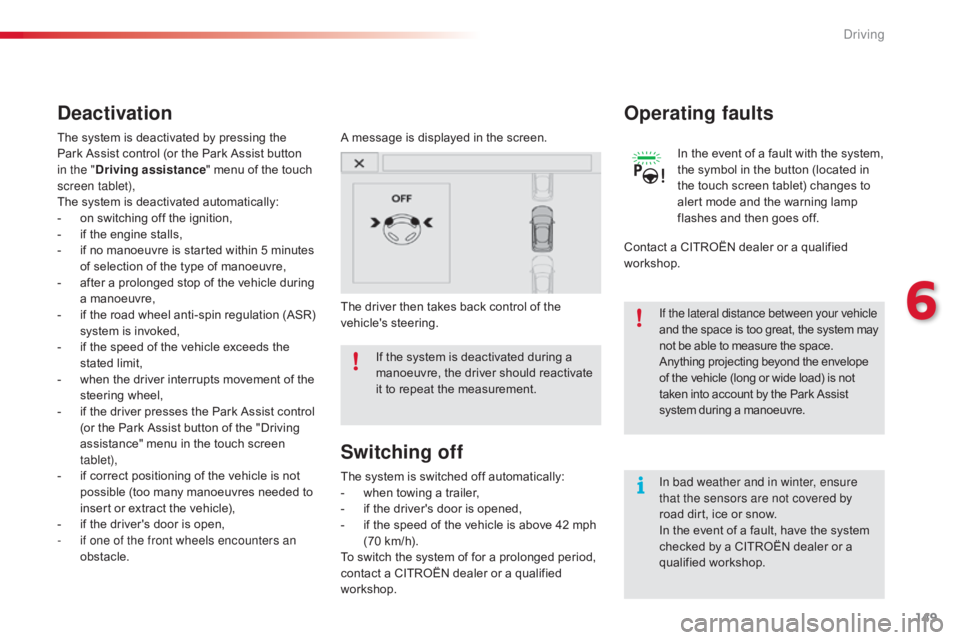
149
C4-cactus_en_Chap06_conduite_ed01-2016
In bad weather and in winter, ensure
that the sensors are not covered by
roadô dirt, ô ice ô or ô snow.
In
ô the ô event ô of ô a ô fault, ô have ô the ô system ô
c
hecked ô by ô a ô CITROûN ô dealer ô or ô a ô
q
ualified
ô w
orkshop.
If
ô
the
ô
system
ô
is
ô
deactivated
ô
during
ô
a
ô
m
anoeuvre,
ô
the
ô
driver
ô
should
ô
reactivate
ô
i
t
ô
to
ô
repeat
ô
the
ô
measurement.
If the lateral distance between your vehicle
andô the ô space ô is ô too ô great, ô the ô system ô may
ô n
ot ô be ô able ô to ô measure ô the ô space.
Anything ô projecting ô beyond ô the ô envelope
ô o
f ô the ô vehicle ô (long ô or ô wide ô load) ô is ô not
ô t
aken ô into ô account ô by ô the ô Park ô Assist
ô s
ystem ô during ô a ô manoeuvre.
Deactivation
Aô messageô isô displayedô inô theô screen.
T he ô driver ô then ô takes ô back ô control ô of ô the ô
v
ehicle's
ô s
teering.
The
ô
system
ô
is
ô
deactivated
ô
by
ô
pressing
ô
the
ô P
ark
ô
Assist
ô
control
ô
(or
ô
the
ô
Park
ô
Assist
ô
button
ô
i
n the " Driving assistance "
ô
menu
ô
of
ô
the
ô
touch
ô
s
creen tablet),
The
ô
system
ô
is
ô
deactivated
ô
automatically:
-
ô
o
n
ô
switching
ô
off
ô
the
ô
ignition,
-
ô
i
f
ô
the
ô
engine
ô
stalls,
-
ô
i
f
ô
no
ô
manoeuvre
ô
is
ô
started
ô
within
ô
5
ô
minutes
ô
o
f
ô
selection
ô
of
ô
the
ô
type
ô
of
ô
manoeuvre,
-
ô
a
fter
ô
a
ô
prolonged
ô
stop
ô
of
ô
the
ô
vehicle
ô
during
ô
a
ô
manoeuvre,
-
ô
i
f
ô
the
ô
road
ô
wheel
ô
anti-spin
ô
regulation
ô
(ASR)
ô
s
ystem
ô
is
ô
invoked,
-
ô
i
f
ô
the
ô
speed
ô
of
ô
the
ô
vehicle
ô
exceeds
ô
the
ô
s
tated
ô
limit,
-
ô
w
hen
ô
the
ô
driver
ô
interrupts
ô
movement
ô
of
ô
the
ô
s
teering
ô w
heel,
-
ô
i
f
ô
the
ô
driver
ô
presses
ô
the
ô
Park
ô
Assist
ô
control
ô
(
or
ô
the
ô
Park
ô
Assist
ô
button
ô
of
ô
the
ô
"Driving
ô
a
ssistance"
ô
menu
ô
in
ô
the
ô
touch
ô
screen
ô
t
ablet),
-
ô
i
f
ô
correct
ô
positioning
ô
of
ô
the
ô
vehicle
ô
is
ô
not
ô
p
ossible
ô
(too
ô
many
ô
manoeuvres
ô
needed
ô
to
ô
i
nsert
ô
or
ô
extract
ô
the
ô
vehicle),
-
ô
i
f
ô
the
ô
driver's
ô
door
ô
is
ô
open,
-
i
f one of the front wheels encounters an
obstacle.
Switching off
Theô systemô isô switchedô offô automatically:
- ô w hen ô towing ô a ô trailer,
-
ô
i
f ô the ô driver's ô door ô is ô opened,
-
ô
i
f ô the ô speed ô of ô the ô vehicle ô is ô above ô 42 ô mph ô
(
70 ô km/h).
To
ô switch ô the ô system ô of ô for ô a ô prolonged ô period, ô
c
ontact ô a ô CITROûN ô dealer ô or ô a ô qualified ô
w
orkshop.
Operating faults
Inô theô eventô ofô aô faultô withô theô system,ô the ô symbol ô in ô the ô button ô (located ô in ô
t
he ô touch ô screen ô tablet) ô changes ô to ô
a
lert ô mode ô and ô the ô warning ô lamp ô
f
lashes ô and ô then ô goes ô off.
Contact
ô
a
ô CITROûN ô dealer ô or ô a ô qualified ô
w
orkshop.
6
Driving
Page 152 of 317

150
C4-cactus_en_Chap06_conduite_ed01-2016
Under-inflationô detection
Theô systemô monitorsô theô pressuresô inô theô fourô t
yres, ô once ô the ô vehicle ô is ô moving.
It
ô compares ô the ô information ô given ô by ô the ô four ô
w
heel speed sensors with reference values,
which must be reinitialised ever y time the
tyre pressures are adjusted or a wheel
changed .
The
ô system ô triggers ô an ô alert ô as ô soon ô as ô it ô
d
etects a drop in the inflation pressure of one
or
ô more ô tyres. The
ô under-inflation ô detection ô system ô
d
oes ô not ô replace ô the ô need ô for ô vigilance ô
o
n ô the ô part ô of ô the ô driver.
This
ô system ô does ô not ô avoid ô the ô need ô to ô
c
heck ô the ô tyre ô pressures ô (including ô the ô
s
pare ô wheel) ô every ô month ô as ô well ô as ô
b
efore ô a ô long ô journey.
Driving
ô with ô under-inflated ô tyres ô impairs ô
r
oad ô holding, ô extends ô braking ô distances ô
a
nd ô causes ô premature ô tyre ô wear, ô
par
ticularly under arduous condition
(high
ô loading, ô high ô speed, ô long ô journey).
System
ô which ô automatically ô checks ô the ô pressures ô of ô the ô tyres ô while ô driving.
The inflation pressures defined for
your vehicle can be found on the tyre
pressure
ô label.
For
ô more ô information ô on ô the ô
i
dentification ô markings, ô refer ô to ô the ô
c
orresponding
ô s
ection.
Tyre
ô pressures ô should ô be ô checked ô
w
hen the tyres are "cold" (vehicle
stopped
ô for ô 1 ô hour ô or ô after ô a ô journey ô of ô
l
ess ô than ô 6 ô miles ô (10 ô km) ô at ô moderate ô
s
peeds).
Other wise
ô (when ô hot), ô add ô 0.3 ô bar ô to ô
t
he ô pressures ô shown ô on ô the ô label.
Driving
ô with ô under-inflated ô tyres ô
i
ncreases ô fuel ô consumption.
Driving
Page 195 of 317
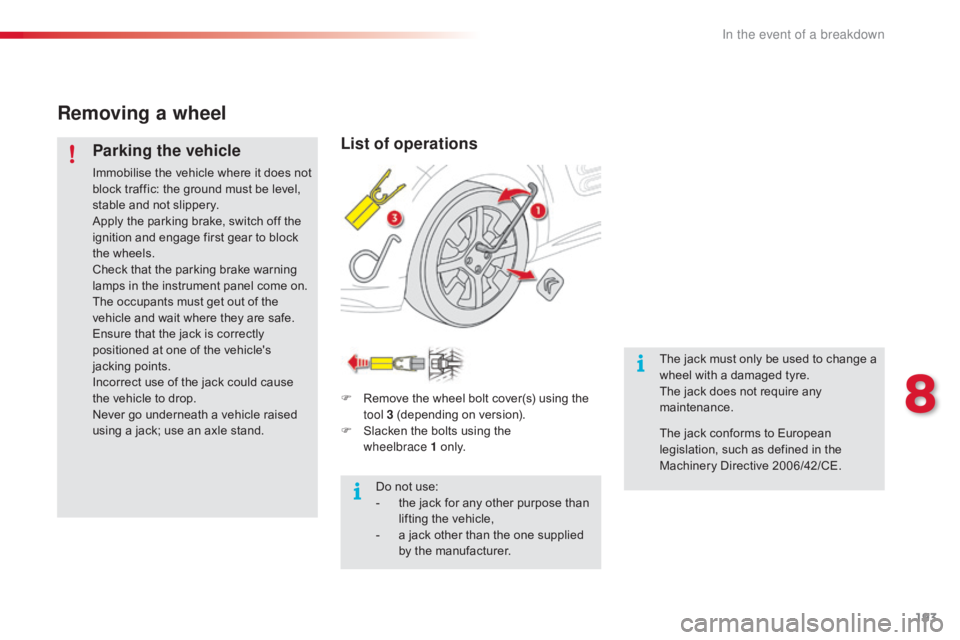
193
C4-cactus_en_Chap08_En-cas-de-panne_ed01-2016
Removing a wheel
Parking the vehicle
Immobiliseô theô vehicleô whereô itô doesô notô block ô traffic: ô the ô ground ô must ô be ô level, ô
s
table ô and ô not ô slippery.
Apply
ô the ô parking ô brake, ô switch ô off ô the ô
i
gnition ô and ô engage ô first ô gear ô to ô block ô
t
he ô wheels.
Check
ô that ô the ô parking ô brake ô warning ô
l
amps ô in ô the ô instrument ô panel ô come ô on.
The
ô occupants ô must ô get ô out ô of ô the ô
v
ehicle ô and ô wait ô where ô they ô are ô safe.
Ensure
ô that ô the ô jack ô is ô correctly ô
p
ositioned ô at ô one ô of ô the ô vehicle's ô
j
acking ô points.
Incorrect
ô use ô of ô the ô jack ô could ô cause ô
t
he ô vehicle ô to ô drop.
Never
ô go ô underneath ô a ô vehicle ô raised ô
u
sing ô a ô jack; ô use ô an ô axle ô stand.
List of operations
Fô Removeô the ô wheel ô bolt ô cover(s) ô using ô the ô t
ool 3 ô (depending ô on ô version).
F
ô
S
lacken ô the ô bolts ô using ô the ô
w
heelbrace
1ô o n l y.
Do
ô not ô use:
-
ô
t
he ô jack ô for ô any ô other ô purpose ô than ô
l
ifting ô the ô vehicle,
-
ô
a
ô jack ô other ô than ô the ô one ô supplied ô
b
y ô the ô manufacturer. The
ô jack ô must ô only ô be ô used ô to ô change ô a ô
w
heel ô with ô a ô damaged ô tyre.
The ô jack ô does ô not ô require ô any ô m
aintenance.
The
ô jack ô conforms ô to ô European ô
l
egislation, ô such ô as ô defined ô in ô the ô
M
achinery ô Directive ô 2006/42/CE.
8
In the event of a breakdown
Page 196 of 317
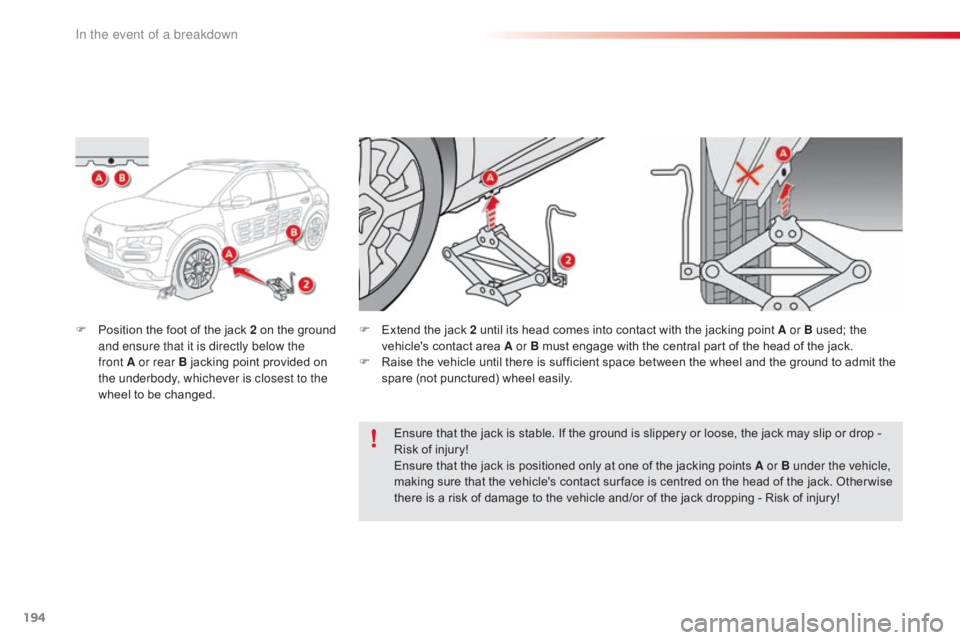
194
C4-cactus_en_Chap08_En-cas-de-panne_ed01-2016
Fô Positionô the ô foot ô of ô the ô jack ô 2 ô on ô the ô ground ô a
nd ensure that it is directly below the
front
A or rear B ô jacking ô point ô provided ô on ô
t
he underbody, whichever is closest to the
wheel
ô to ô be ô changed. F
ô E xtend ô the ô jack ô 2 ô until ô its ô head ô comes ô into ô contact ô with ô the ô jacking ô point ô A or B ô used; ô the ô v
ehicle's ô contact ô area ô A or B ô must ô engage ô with ô the ô central ô part ô of ô the ô head ô of ô the ô jack.
F
ô
R
aise ô the ô vehicle ô until ô there ô is ô sufficient ô space ô between ô the ô wheel ô and ô the ô ground ô to ô admit ô the ô
s
pare ô (not ô punctured) ô wheel ô easily.
Ensure
ô that ô the ô jack ô is ô stable. ô If ô the ô ground ô is ô slippery ô or ô loose, ô the ô jack ô may ô slip ô or ô drop ô - ô
R
isk ô of ô injury!
Ensure
ô that ô the ô jack ô is ô positioned ô only ô at ô one ô of ô the ô jacking ô points ô A or B under the vehicle,
making
ô sure ô that ô the ô vehicle's ô contact ô sur face ô is ô centred ô on ô the ô head ô of ô the ô jack. ô Other wise ô
t
here ô is ô a ô risk ô of ô damage ô to ô the ô vehicle ô and/or ô of ô the ô jack ô dropping ô - ô Risk ô of ô injury!
In the event of a breakdown